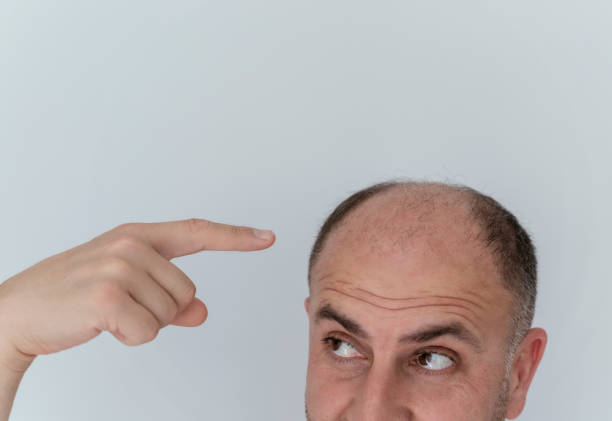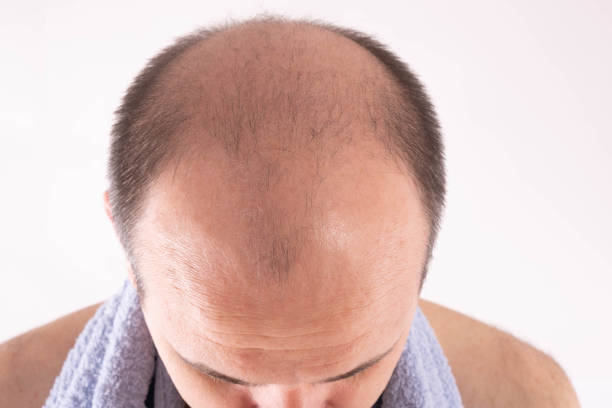Many people search for the best male pattern baldness treatment in Pakistan so that they can restore their lost hair and glory. Pattern hair loss tends to happen in almost 85% of the men worldwide. Most of the men experience hair loss at some part of their life. Up to 100 strands are fallen out daily and it is thought to be normal. However, the situation is alarming when the count is more than already mentioned and you start seeing visible patches on your head, which not only looks dissatisfying but is also stressful for a lot of people. This type of hair loss can occur at any age however, the likelihood is less in teenage and the risk increases with age. Male pattern baldness is known by this name because it tends to happen in a telltale shape that is starting from receding hairline. The hairs become thinner with time and after a few weeks, the growth is only restricted to the temporal area. Androgenic alopecia is caused by a male sex hormone, dihydrotestosterone, DHT, which is responsible for the development of male secondary sex characters. It is also responsible for growth in some parts of the body. However, some individuals are sensitive to this hormone and binding of this hormone to the sensitive receptors resulted in shrinkage and breaking of follicles. If you are facing hair loss then no need to worry as male pattern baldness treatment in Pakistan is available now through follicular unit extraction technique.
Common causes of male pattern balding
Androgenic alopecia is the most common cause of male pattern baldness. Other causes may include trichotillomania. It is a stress related disorder and occurs mostly in teenagers when they tend to pull out hairs in response to stress or anger. Telogen effluvium is a condition in which the resting phase (telogen phase) becomes dominant. As a result, no new hairs are formed whereas the rate of falling hairs is increased, which can be triggered by slight stimuli such as combing or merely touching. Alopecia areata is another condition justifying baldness in men which is genetically related. AR is a gene responsible for the expression of androgen receptors which binds the hormone DHT. Genetically, males who have overexpression of these receptors, experience thinning at a much faster rate. Several other factors include medicines, certain medical processes such as chemotherapy, disease mediated shedding such as thyroid disorder induced can lead to baldness in male. Taking a poor diet or deficiency of keratin in the body can also result in shedding. Sometimes, it can also occur due to infectious agents as tinea capitis is a fungal infection of the scalp in which the hairs tend to fall out.
Sign and symptoms of male pattern baldness
Male pattern baldness can be identified by considering a number of steps in your routine. One of the signs to detect hair fall is to check out hairs on your comb and pillow. As we already know that hair falling is a natural process but if you are noticing more hair fall during showering or combing, this might be an alarming sign. The crown of the head is the top portion of the head. If you notice any thinning at the crown using a mirror, this is an early sign of balding which may lead to formation of visible patches, in most cases. Classic early sign is a receding hairline. It may first occur at the temporal region or recede all the way across. Hairs overall thickness can be compared to previous photos and thinning of hair can be identified easily. During telogen effluvium, your hair takes longer to grow. Balding or visible spots are easily identifiable by the same barber you have been visiting since years. Itching might sometimes be a sign of folliculitis which contributes to hair fall. Moreover, thinning of hairs is a direct sign that leads to hair loss.
There is no possible way male pattern baldness can be prevented, especially if it is genetically related. However, there are a number of techniques and procedures which might be employed in order to regrow hairs and improve the overall thickness. Some of the natural ways that are known to improve hair growth include massaging the scalp with oils. Several oils have been found to give promising results such as coconut oil, olive oil. Rosemary oil, peppermint oil. These oils improve the circulation of blood towards the scalp, hence bringing more blood to follicles and increasing their growth. MPB can also be treated by using a number of prescription and non-prescription medications. Nonprescription drugs include minoxidil, collagen based medications and vitamin supplements containing biotin. These medicines are available OTC in a wide range of product lines such as shampoos and foams to increase ease of application. Prescription medicines include corticosteroids, finasteride, anthralin and methotrexate. They are prescribed after detailed examination and scalp biopsy performed by a doctor in order to identify the root cause of hair fall as these medications can lead to serious side effects, if given without proper diagnosis.
Last option for male pattern baldness treatment in Pakistan is surgery. Among various surgical options available, the best one is selected after discussing the suitability criteria with the dermatologist in detail. The factors which are to be considered include the cost of procedure, total expense including the travelling expenses and the post-operative expense, skills and experience of the doctors. FUE and FUT transplants are mainly employed. In FUT, a strip of donor area is removed and placed in the recipient area where increased growth is intended. In FUE, hair follicles are extracted individually and then placed in the area showing patches. MPB can also be treated by ARTAS robotic hair transplantation technique available in developed countries. In this process, the hairs to be extracted are selected by a robot and extraction and harvesting is also completed using a robotic arm. This is a more precise procedure. Lastly, stem cell transplantation technique has also been proved beneficial in treating hair fall problems. In this process, biopsy of the scalp is performed to extract stem cells which are separated by ultracentrifugation. A stem cell suspension is made and injected in the desired area. Before selecting a procedure, it is necessary to know what is, male pattern baldness, its root causes, diagnostic features and treatment strategies available.
The pattern differs in men and women. There are many reasons, it could be a genetic problem or as a result of any medical condition. Before performing hair transplant, a patient should know the exact cause. If you’re facing such problems, you’re not alone. It is the most universal and common form of men’s hair loss across the globe.
Ages of males with Androgenetic Alopecia:
- 18 to 29 = 15% to 30%
- 30 to 39 = 35% to 40%
- 40 to 49 = Nearly 45%
- 50 to 59 = 55%
- 60 to 69 = 65%
Pattern baldness is mostly caused due to androgenetic alopecia, also known as common alopecia in men Genetically; this disease is inherited from either your father or your mother. It is necessary to find out the reasons after recognizing definite signs. Surgical and nonsurgical treatments are available in many clinics and hospitals in Pakistan for the treatment of this disease. But before starting the treatment, always discuss with your doctor first. Dihydrotestosterone (DHT) hormone is directly responsible for this disease. DHT binds with an enzyme called alpha five reductase and abundance of this enzyme in the hair strands causes male pattern hair loss. One of the treatments of the disease is to obstruct the formation of DHT.
Drugs
Prescribed by doctors, radiation and other therapies are also the reasons for the complete alopecia. Burns formed by these can deeply harm the bare skin and cause alopecia. Unnecessary intake of vitamin A becomes harmful for the body and leads to alopecia. Some severe illness also leads to complete hair loss like:
- Thyroid disease
- Syphilis
- Ringworm
- High fever
However the issue can be fixed easily after consulting your doctor or diagnosing the disease properly.
Treatments:
Hair Transplantation
If you are experiencing male pattern baldness then you should go for a surgery. Find a dermatologist first and discuss everything with him and he’ll suggest you the best possible treatment.
The most common or available options are
- Wigs
- Medications
- Hairpieces
- Hair transplant
FUE or Strip method:
In Follicular transplant, the surgeon takes the follicles from the back side of your head and implants them on the bald areas. This treatment gives very natural looking results.
Grafts can also be transplanted into the bald skin and the methods, strip and FUE produce excellent results and permanent solution. However, FUE hair transplant is a bit expensive one.
Scalp reduction:
In this method, the bald skin can be surgically removed. After the removal, the hair covered the scalp . In Pakistan, many hospitals or clinics are famous for these transplants, leading ones are:
- Cosmoderma Clinique (Lahore)
Some Other Medical Treatments:
Minoxidil and Propecia are used as a medication to reduce shedding. Propecia is taken every day in the form of tablets. Propecia forbids the enzyme activity and stops miniaturization however; it is not prescribed for females. Minoxidil is a form of lotion and rubbed on the scalp to stop hair loss. It increases the growth of hair and their growing period.
Frequently Asked Questions
Which clinic is the best for male pattern baldness treatment in Pakistan?
Our clinic has been treating receding line or evolving balding patterns successfully for the last 22 years in Pakistan. We have foreign qualified and trained hair specialists at our clinic in Pakistan.
What is the cost range of male pattern baldness treatment in Pakistan?
The price to treat newly started hair fall is less as compared to fully mature alopecia.
How to get an idea of cost of treatment?
To get an idea of cost and treatment options you may send your thinning or affected part of head through WhatsApp +923334309999
People also search
| 2587 grafts photos | 3087 grafts photos |
| 2500 grafts result | 2851 grafts result |
Ask a doctor | Write us or WhatsApp | +923334309999



